Varanasi, India’s spiritual capital, is set to leave behind centuries of chaos. Urban governance is the new mantra in the PM’s constituency
As you drive down from Varanasi airport, the elevated road that takes you to the city says it all. It takes less than 20 minutes to reach the cantonment area where the British established their garrisons and other establishments to administer the city.
Varanasi, one the world’s oldest cities, is bracketed by two rivers, Varuna and Assi, from whom it derives its name. There are myths galore about Varanasi.
In Mark Twain’s description, it is “older than history, older than tradition, older even than legend”. In Hindu mythology, this sacred place is the centre of the earth. For this precise reason, the panchkroshi parikrama, a circumambulation around this geographical space, is considered a pilgrimage which covers the entire world.
But Varanasi now exists between antiquity and a newfound modernity. The driveway from airport to the city is comparable to the best approach roads around airports in any city in the country. For a moment, it gives the impression of driving down on the elevated roads of any of the country’s metropolises.
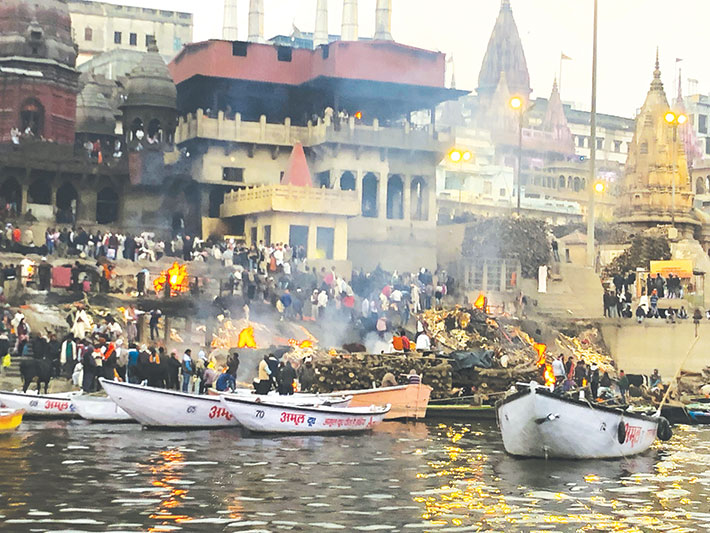
Photos: Ajay Singh
For those who have seen Varanasi regressing aesthetically, culturally and socially for decades on end, the sight of the city transforming into a larger urban entity with modern facilities is quite pleasing. By all accounts, Varanasi appears to be in the throes of a major transformation that emanates for the city’s unique political empowerment.
Though Varanasi was known by many names, even called the “metropolis of Hindu faith” and identified with theological heterodoxy thanks to the presence of Jainism and Buddhism here, it was seriously crippled by one limitation – it never had a conventional political power, especially since independence. Except for a brief period when Pandit Kamlapati Tripathi was the chief minister of Uttar Pradesh in the 1970s, the city did not have political muscle. As a result, urban development and infrastructure always took a backseat. There was never a serious attempt to build infrastructure on the outskirts and provide modern amenities to decongest the core and expand the urban area. In essence, the city was allowed to be stagnated and degenerated into the worst kind of slum over the past six decades.
But now Varanasi is enjoying its prime status. Never in modern history was it as much politically empowered as it is now. Since prime minister Narendra Modi represents Varanasi in the Lok Sabha, he frequently visits the city and often brings with him visiting heads of state. Almost every two weeks, one can find chief minister Yogi Aditynath paying a visit to assess the progress of developmental projects. “We are so used to high-profile visits that the administration is perpetually on alert,” said an officer handling VIP visits to the city.
If Rome was not built in a day, it would be unfair to expect an even more ancient city like Varanasi to complete its metamorphosis in four and a half years. Yet the signs of a profound change are quite visible. What Mahatma Gandhi wrote about his 1916 visit to the city seemed perfectly applicable to 2014 – but not now.
In the holy city to attend the inauguration of the Banaras Hindu University, Gandhi also paid a visit to the Kashi Vishwanath temple, one of India’s most important temples. Instead of feeling uplifted, he was horrified. “I visited Vishwanath temple last evening and as I was walking through those lanes, these were the thoughts that touched me. If a stranger dropped from above on to this great temple and he had to consider what we as Hindus were, would he not be justified in condemning us? Is not this great temple a reflection of our own character?” he wrote on February 6, 1916.
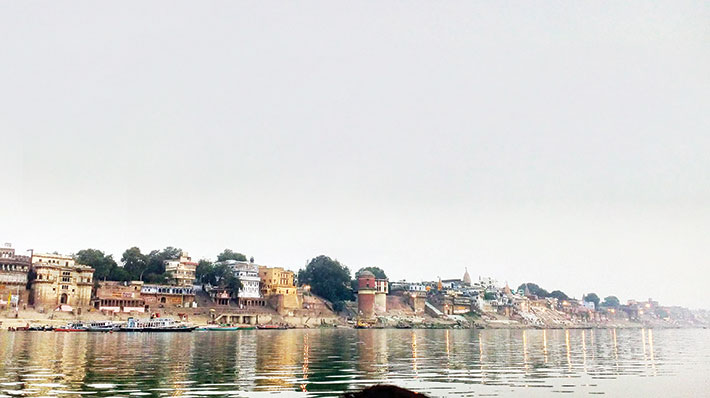
Photos: Ashish Mehta
In his visionary way, Gandhi noted specific grievances, and from there he drew lessons in self-rule for India. “Is it right that the lanes of our sacred temple should be as dirty as they are? The houses round about are built anyhow. The lanes are tortuous and narrow. If even our temples are not models of roominess and cleanliness, what can our self-government be? Shall our temples be abodes of holiness, cleanliness and peace as soon as the English have retired from India, either of their own pleasure or by compulsion, bag and baggage?”
That dream, however, remained unfinished for decades after the English left India. Gandhi’s lament went unheeded largely because of a secular narrative espoused by the subsequent regimes till 2014. That narrative was grossly challenged when Modi came to power and a new discourse was consolidated when he installed the Mahant of Gorakhdham Peeth, Yogi Adityanath as the chief minister of Uttar Pradesh in 2017. Since then, the Kashi Vishwanath temple complex has been undergoing a major transformation. A development authority has been set up to pave the way for the reconstruction of the temple surroundings on a grand scale, probably comparable to the Somnath temple restoration initiated by Sardar Vallabhbhai Patel.
Consider the scale at which these changes are taking place. Till two years ago, the total area of the Kashi Vishwanath temple, one of the holiest of holy sites of Hinduism, was barely around 2,400 square feet, equal to a three-bedroom flat in a city. With the acquisition of all buildings around the temple extending up to the Ganga, the temple complex would expand to almost 4 lakh square feet. Of course, as tens of thousands of pilgrims – from every corner of India and also abroad – throng the temple every day, and the number goes up to unmanageable proportions on special occasions, such an expansion was indeed long overdue. An official of the authority said that the government had spent nearly Rs 250 crore in acquiring the houses that were illegally built in narrow lanes which were not only aesthetically distasteful but also a cause of concern for law and order. The entire area would be shortly come under the complete control of the new authority.
Vishal Singh, a young IAS officer who is entrusted with the task of restoring the temple’s grandeur, conducted me on a tour of this zone and pointed out that many squatters had in fact occupied smaller, ancient temples which were in the vicinity of the grand main temple, and built houses over them, completing hiding the religious structures. “We are restoring these temples and making them part of resurrection and beautification of the temple site,” he said.
The project initially faced resistance from some of the locals but it was overcome with determined efforts of the administration and liberal compensation and resettlement packages. Ironically, this temple project was initiated without preparing a detailed project report (DPR). The reason was obvious. Since the temple was surrounded by squatters as well as genuine house owners, it was next to impossible to envisage the final shape of the project. As of now, the officials proceeding by studying historical maps and scriptures to determine the original contours of the temple. It appears quite evident that the corridor of the temple that opens up on the bank of Ganga would be enormously wide.
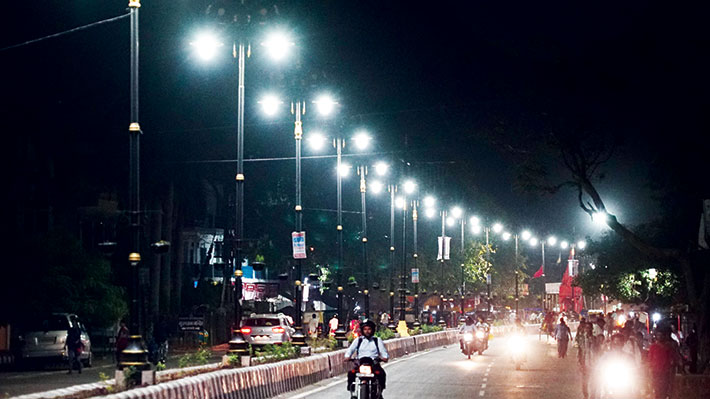
Photo: Arvind Kumar
The fear that the temple’s expansion would adversely affect the adjacent Gyanvapi mosque is not only unfounded but patently mischievous. Despite the coexistence of the two religious structures for centuries, people of Varanasi and even pilgrims have never bitten the bait of a section of hardline Hindu organisations that claim rights over the mosque. Even at the peak of the Ayodhya agitation, the Vishwa Hindu Parishad’s call for mobilisation at Sringar Gauri behind the Gyanvapi mosque proved to be a non-starter in 1993. Since then, the detour to the mosque side of pilgrims has been restrained effectively.
Urban rejuvenation
The temple complex reconstruction and expansion is inevitably symbolic of the metamorphosis of the whole city. A slew of projects that are under way have the potential of making Varanasi the most attractive urban centre of eastern India.
A jetty has come up at Ralhupur, about five km downstream of the river and adjacent to Ram Nagar where the king of Varanasi used to live. The jetty will open the water route for commercial purposes. In December, Modi inaugurated this multi-modal terminal as a shipload of automobiles arrived here from Kolkata. The infrastructure project is in the process of completion. It is expected to create a lot of economic activity once the water route becomes viable. Meanwhile, cruise ships carrying tourists have started sailing from Kolkata to Varanasi on pilot basis.
The healthcare infrastructure too has been substantially improved. The Sir Sunderlal Hospital and the Institute of Medical Sciences at the BHU has been made equal to the All India Institute of Medical Sciences (AIIMS). A top-class cancer hospital and a regional institute for ophthalmology have been set up to cater to patients of not only from the eastern parts of the country but also from neighbouring Nepal.
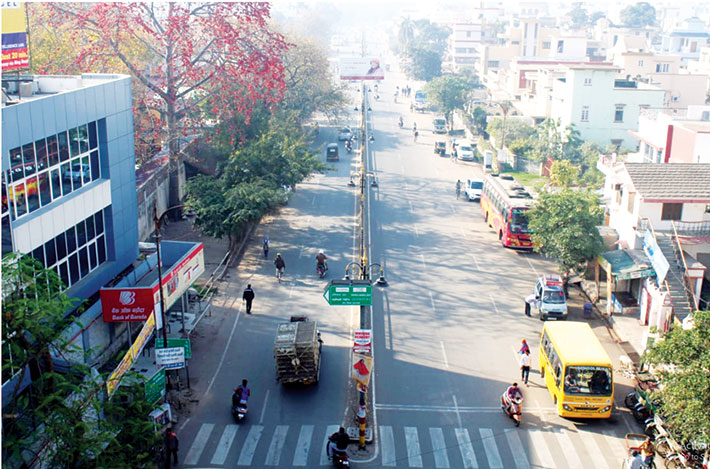
Photo: Arvind Kumar
All around the BHU and across the city, heritage lights illuminate the streets that used to get plunged into darkness before 2014. Many flyover bridges are constructed across the city to ease the traffic which has grown manifold over the years and make commuting in the city extremely excruciating experience. There are plans to turn certain dense parts of the city into exclusive pedestrian zones to avoid traffic jams. At the same time, there is proposal to facilitate commuting through ropeway trollies in the areas which are densest.
Challenges ahead
Obviously, there are challenges at every corner. The city’s existence spreads over millennia, and it is not an easy task to bring it up to the 21st century.
The sacred geographical patch lying between Varuna and Assi known as Kashi (city of lights) is known to have the highest population density on the planet. Over centuries people came and settled in this region believing it to be the holiest of the holy places for Hindus. The lanes have remained the same that Adi Shankaracharya or Guru Nanak, Kabir or Tulsidas must have traversed, but now SUVs ply on them. The core area has remained the same over the centuries but the population has multiplied several times.
The cultural attitudes and the mindset too come in the way of development. The Kashi Vishwanath temple complex is set to extend in a corridor ending at the Harishchandra Ghat. This is where Hindus come from far to perform last rites of their near and dear ones, and as a result the site does not present a pretty picture – with obnoxious fumes from constantly burning pyres, body parts left over and dogs running here and there. By tradition, this Ghat is under the control of Dom Raja and his community, and efforts have been made to encourage the use of the electric crematorium. But it will take time to make the place environment-friendly.
The environment is also under stress in the river stream where boats taking pilgrims and tourists on ride run on diesel. The otherwise pristine experience of a ride in the Ganga is tinged with a nasty smell. Boats running on electricity were introduced to clear the air, but the community that ply the boats will have to come around to a sustainable mode of business.
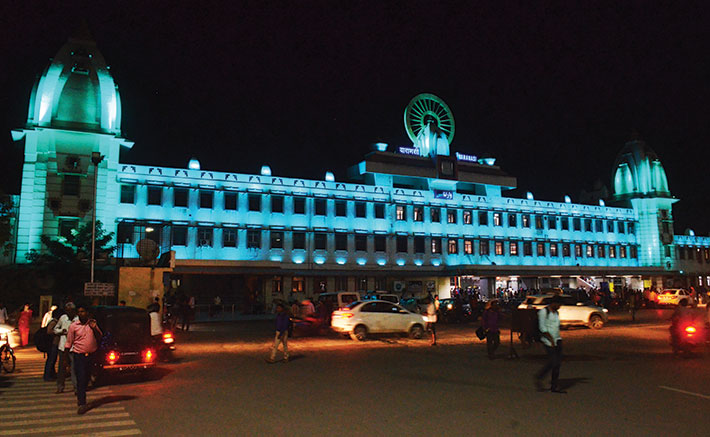
Photo: Arvind Kumar
The positive note, on the other hand, is that the mindset is already changing, beginning with the younger generation. Also, the changes already accomplished are consolidating the can-do attitude.
The man in the middle of all this is Modi. As Varanasi is the PM’s constituency, the rusted wheels of the bureaucracy are moving again. Within the past four years, a sum of Rs 20,000 crore has been spent on various projects. Varanasi is gradually developing as a unique model of an urban centre which, while retaining it antiquity and purity, would have most modern amenities comparable to anywhere in India.
This is what Gandhi had envisioned. Writing in Navjivan on February 29, 1920, he lauded the role played by Pandit Madan Mohan Malviya for founding a university in Varanasi and said, “it is the task of every Hindu to find way to remove inner and outer defilement that has crept into the Hindu religion and every Hindu, even sitting in his own home, can make a start this very day. If each one is scrupulous about his own cleanliness, the Kashi Vishvanath would soon be as clean as we could wish”. Nearly 99 years after Gandhi’s prescription, Modi seems quite determined to ensure at least outer cleanliness of not only the Vishvanath temple but also of the entire Varanasi area and its outskirts.
ajay@governancenow.com
(This article appears in the March 15, 2019 edition)

